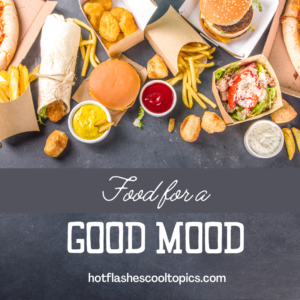
Unhealthy eating can affect our moods. In fact, “evidence shows that food can contribute to the development, prevention, and management of mental health conditions, including depression and anxiety disorders.” (1). A new book Eat & Flourish discusses the connection between food and our mental health and shares insights into how we can improve our mood through food.
Mary Beth Albright, a former food attorney and food expert, is the author of Eat & Flourish, How Food Supports Emotional Well-Being. In this book, Mary discusses the connection between the foods we eat and our mental health, the history behind the word “hangry”, the roles of serotonin and the gut microbiome, and the connection between inflammation in the body and mental health. When we eat something, our bodies have a biological response that can directly affect our mood and mental state. While research surrounding food is hard to conduct on humans, for there are too many uncontrolled factors, scientists have done testing on mice to study the connection. Mary writes about a specific study conducted on mice studying their gut microbiome. Through the testing, researchers found that mice that had experienced early childhood trauma, such as being separated from their mothers or being stuck in captivity, have a different gut microbiome makeup than other mice and experience more symptoms of depression and anxiety. When those mice were then given a probiotic, the decreased stress response they had was similar to the effects of Lexapro.
Science indicates that humans have four fundamental emotions: SAD, MAD, GLAD AND SCARED. There are certain foods that can actually help manage and cope with each emotion.
- SAD: Foods that help with sadness include dark chocolate, hot peppers, eggs and turmeric
- MAD: Foods that help manage anger include salmon, tuna, pumpkin seeds, beans, lentils and leafy greens
- GLAD: Foods that help focus on being happy include oysters, leafy greens and nuts
- SCARED: Foods that help cope with fear include citrus fruits, yellow peppers, kale, broccoli, sprouts and strawberries.
Since the emotional connection between our mood and food is deep, ignoring our emotions can have negative effects. When we suppress our emotions, cortisol can build in our bodies. To combat this, Mary suggests having a dietary food pattern or eating around other people can help improve your mood and decrease the buildup of cortisol in your body.
What is PING? Mary created the acronym PING which stands for: pleasure, inflammation, nutrients and gut microbiome. After doing a great deal of research, Mary found that in all the studies she read, pleasure, inflammation, nutrients, and gut microbiomes were four things greatly impacted by food. Mary explains that evidence shows that one way of addressing emotional well-being is eating patterns that may include a variety of nutrients, pleasure (with friends), microbiome support foods and anti-inflammatory foods. Other recommendations include:
- Eat at set intervals throughout the day
- Choose less refined sugars and eat more whole grains
- Include protein at each meal
- Eat a variety of foods
- Include omega-3 rich foods, like oily fish, in your diet
- Reach and maintain a healthy weight
- Drink plenty of fluids, especially water
- Get regular exercise (1)
Eat & Flourish also discusses the phenomenon known as “hangry”, when a person becomes so hungry that they get irritable and upset. Mary explains the connection between hunger and anger comes from AGRP neurons, which are connected directly to our gut. Hunger and anger are bundled in the same neuron, and it is believed that this comes from years of evolution. Centuries ago, hunger pains were not intense enough to cause a person to want to seek out food. Researchers believe that to rectify this, our bodies evolved and combined hunger and rage into neurons to ensure we would eat when hungry.
It is important to note that serotonin plays a vital role in the relationship between our emotions in food. In the gut microbiome, a place where trillions of bacteria, viruses, and fungi are housed that live in our digestive tract, over 90% of the body’s serotonin is produced. Since the bacteria in our body influences social anxiety, sleep, metabolism, and more, our gut microbiome heavily affects our serotonin, which in turn influences our mental health. People with more diverse microbiomes tend to have better health outcomes, and the book also shares how a study showed that people who ate 30 plants per week had more diverse gut microbiomes than people who ate 10 plants per week.
What about ultra-processed foods and inflammation? It is believed that more than half of the average American’s diet is 60% processed foods. Ultra-processed foods can lead to inflammation, and inflammation anywhere in the body can affect our brain and mental health. The book references a study conducted where two groups were housed at the National Institute of Health for four weeks and fed different foods. For the first two weeks, one group was fed exclusively ultra-processed foods while the other was given only whole foods, and during the last two weeks, the groups switched. The results of the study showed that the group eating only ultra-processed foods ate 500 more calories a day than the group eating whole foods.
There are many factors that play into mental health. Nutrition is one piece in your “mental health toolkit” that can support emotional well-being. Moderation, connection and nutrition are all vital factors that can help increase and create a better sense of health and well-being.
(1) What is the Relationship Between Food and Mood? Mental Health, First Aid